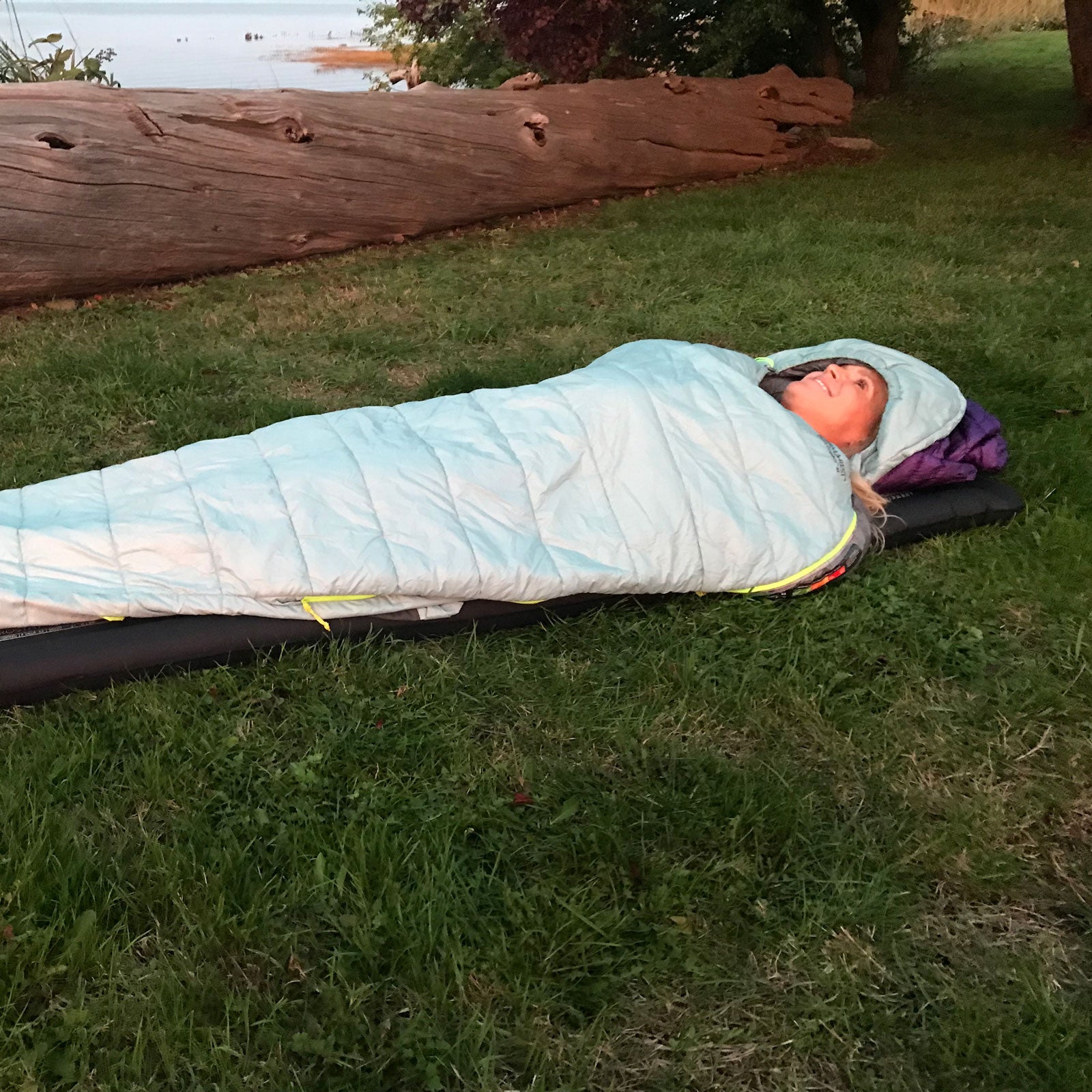The easiest way to ruin a backpacking trip is to bring��the wrong sleeping bag. There’s nothing worse than ending up cold, or fighting a stuck zipper, or waking up in the rain and realizing your down insulation is soaked. For this review, I recruited a team of ten people to research and test the best sleeping bags on the market. Our favorite bag for three-season use, in temperatures from 50 degrees to well below freezing, was the REI Co-Op Magma 10 (or for women). I’ve also recommended��bags for people on a budget and��folks who need bags that are ultralight or extra comfortable, but for most backpackers, the Magma wins in performance and price. Stuffed with top-of-the-line goose down and made with other quality materials, the Magma packs small and weighs less than two pounds��but costs the same as more middle-of-the-road bags.
Our Favorite Backpacking Sleeping Bag
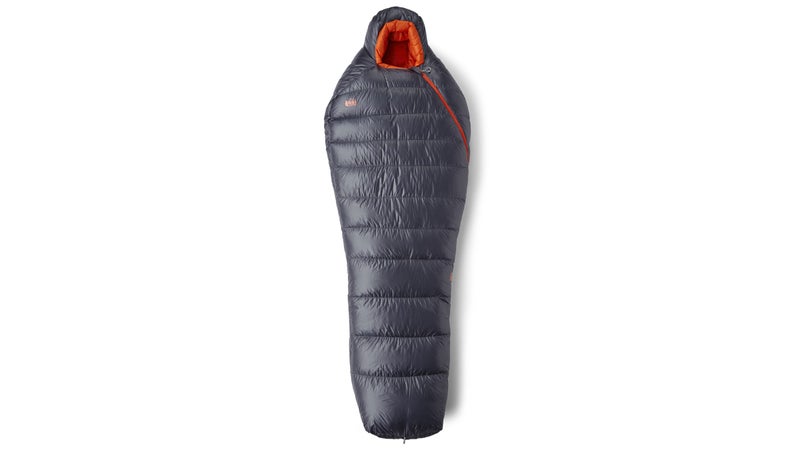
REI Co-Op Magma 10��($350)
REI gave the Magma 10��high-quality, hydrophobic, 850-fill goose-down insulation��and wrapped it in a super-light, 15-denier ripstop nylon Pertex Quantum outer shell. The Magma packs down to the size of a small watermelon��and weighs just shy of two pounds, stats that would be good for a 20-degree bag��but are remarkable for one as warm as the Magma. And while it’s possible to find lightweight warm bags, they��usually cost around��$500, like the 19-degree version of Patagonia’s 850 Down Sleeping Bag. The Magma is warmer and sells for $350.
The Magma’s warmth-to-weight ratio is partly the result of its bio-mapped insulation design. REI stuffed down into narrow��baffles around the chest, into wider ones on the lower bag, and into separate pockets at the shoulders. The idea is to concentrate warmth where it’s needed most��and, coupled with a narrow fit (the fit here is REI’s trimmest), shave a few ounces off the bag’s weight. In my testing, it worked: I still had room to shift from side to side, and the footbox was contoured enough to be comfortable and snug enough to be warm. On a near-freezing night during a backpacking trip in Bryce Canyon National Park, the Magma heated up fast, and ten hours after climbing in I was still cozy and comfortable. Another member of my test team took the Magma out in temps approaching its lower limit and also stayed warm; he said the double adjustment points on the hood helped eke out a little more warmth when pulled snug.
Our test team also loved the Magma’s liner. “It was soft and breathable, not slick and sticky like a lot of them,” one wrote. Ditto for its zipper, which runs smoothly��and doesn’t snag, thanks to a triangular��zipper head and an anti-snag strip of fabric running its length. The downside to all that warmth is that in warmer weather, I sweated, breathable liner notwithstanding. On nights above 45 degrees, this bag was too much.
But that’s a mild complaint. The Magma is lightweight, highly packable, and comfortable. It would be my choice for three-season backpacking in the mountains (four-season in decent conditions), long expeditions, and, with its water-resistant down, even multi-night canoe trips.
Best Synthetic Backpacking Sleeping Bag

Marmot Ultra Elite 30��($189)
If I didn’t know differently, I would have guessed was a down-stuffed bag. It packed small and weighed about the same (1.8 pounds) as down bags in the 30-degree neighborhood. Uncaged in a tent, it ballooned into an impressive pile of warmth. All of which is to say, this is a warm and light bag, and impressively so given its insulation material.
About that insulation: the Ultra Elite is stuffed with a blend of three synthetic fibers that the company calls ElixR. One fiber is meant to optimize thermal efficiency, another loft, and the third durability. The different fibers are��layered in multiple thin strips, then laid shingle-style near the chest of the bag to optimize loft��and in a sheet on the bottom to reduce seams.
The strategy seems to work. I stayed warm in the Ultra Elite 30 on a trip to Vancouver Island when temperatures dropped to the low thirties. The anatomical footbox was roomy, the full-length zipper ran smoothly, and the hood was snug and warm. The Ultra Elite 30 isn’t as warm as the Magma 10 (above), but if you don’t plan to camp in very cold temperatures, and if you want light and packable but don’t have the budget to buy feathers, there’s a lot to like with this bag. In fact, there’s very little reason to miss��down at all.��
Best Lightweight Backpacking Sleeping Bag
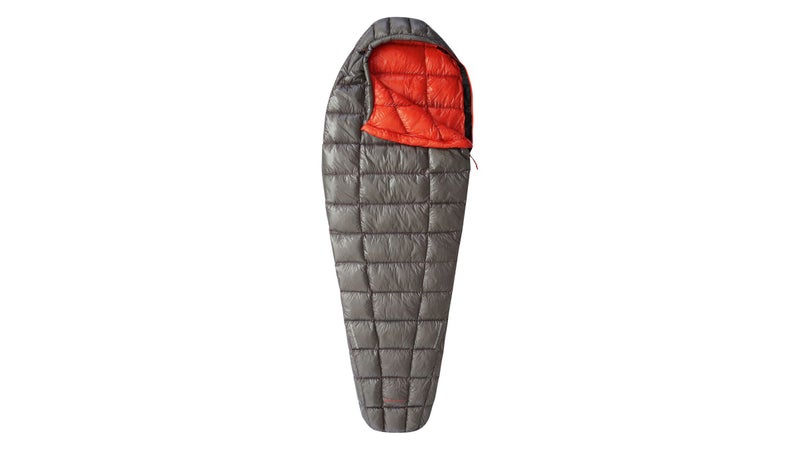
Mountain Hardwear��Ghost Whisperer 40��($400)
My sleeping bag is usually the bulkiest thing in my pack, but ��weighs just over a pound and crushes down to the size of a grapefruit, about the same size and weight as a down jacket. The Ghost Whisperer is stuffed with 900-fill down, the lightest, warmest, and most packable down in Mountain Hardwear’s line. The company also used a fluorocarbon-free hydrophobic treatment and says the down is responsibly sourced. The Ghost Whisperer is wrapped in light ripstop nylon��and stitched with a baffle��pattern reminiscent of a down puffy. It’s not cheap at $400, but I think it’s reasonably priced given its��high-end materials. (If price is a bigger concern than portability, Therm-a-Rest’s 45-degree-rated Space Cowboy, below, is almost as light as the Ghost Whisperer and significantly less expensive at about $150. But it isn’t as packable.)
To be clear, this is a pretty specialized sleeping bag. The mummy dimensions are��on the narrow side, the translucent outer shell demands care, and I had to snuggle in deep to stay warm when the mercury dropped below 50. But if you’re willing to sacrifice some money and a little comfort to go fast and light, you can’t do much better. The Ghost Whisperer helped me crush a quick time on a fast-and-light backpacking trip on Vancouver Island, and I’d recommend it to anyone planning similar missions, including bikepackers. In moderate climates, this is the go-to bag when weight and packability are paramount.
Best Backpacking Quilt
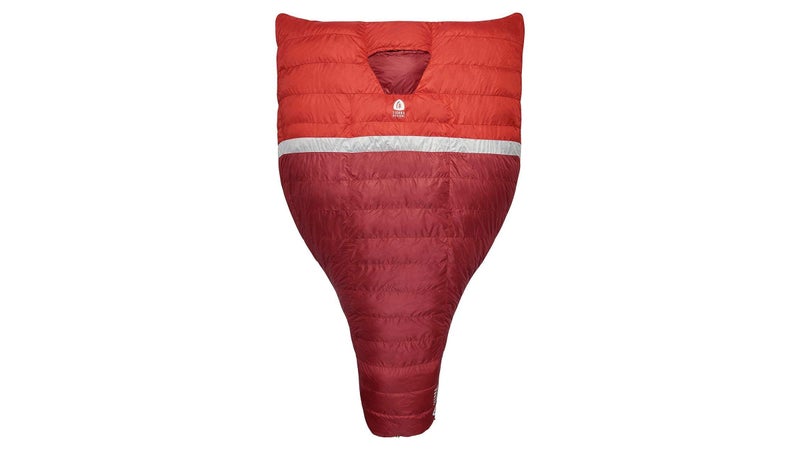
Sierra Designs Backcountry Quilt 700/20��($250)
The Backcountry Quilt is a blanket, except it’s a blanket made with hydrophobic, PFC-free 700-fill down and featuring a couple extra sleeping-bag-like details. On warm summer nights, quilt-style sleeping blankets like the Backcountry Quilt make camping feel like sleeping at home: you can sprawl, stretch, and toss unconstrained, and they’re usually lighter than actual sleeping bags. With a sheet to cover my sleeping pad on summer nights, I was Goldilocks-comfortable slumbering under the Backcountry Quilt.
But most quilts stop making sense when it gets cold, and chilly temps are where the Backcountry Quilt separates itself from blankets like the , which lacks a hood and zipper and doesn’t play nice in cooler weather. The Backcountry Quilt has arm sleeves that let you wrap yourself up Slanket style, a mummy��footbox for tucking your feet, and even a sneaky and well-designed hood. Plus, it weighs only 850 grams.
Those features make the Backcountry Quilt the first legitimate three-season quilt-style sleeping bag I’ve tried. It wouldn’t be my first choice for high alpine trips, where cold nights are expected, but I tested the Backcountry Quilt below freezing and stayed warm. For paddlers and fair-weather backpackers who probably won’t need a warm bag��but might, it provides a tough-to-beat mix of versatility, low weight, and insurance against an unexpected drop in temps.
Best Value Down��Sleeping Bag
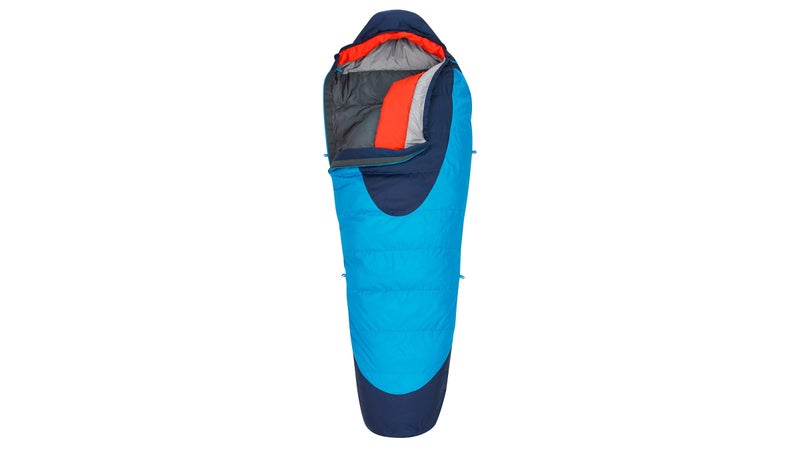
Kelty Cosmic 20��($160)
The ��is a no-frills mummy, and at $150 for a 20-degree-rated down bag��it’s a great deal. Yes, it’s stuffed with heavier 600-fill duck down��and wrapped with a burly 50-denier ripstop polyester shell, meaning it only compresses to about 11 liters. And it’s heavy at three pounds. But our testers said it was soft and a pleasure to use, and a hydrophobic down sleeping bag for less than $200 is rare. One rated to 20 degrees is rarer still.
Plus, Kelty really nailed the details: the hood-adjustment pulls are different widths for easy fiddling in the dark; the footbox is roomy and ergonomic; and a draft collar lines the full-length zip, along with an anti-snag strip that was (mostly) functional. For budget-conscious backpackers, there aren’t any sleeping-bag deals better than this one.��
��
Best Value Synthetic Sleeping Bag��
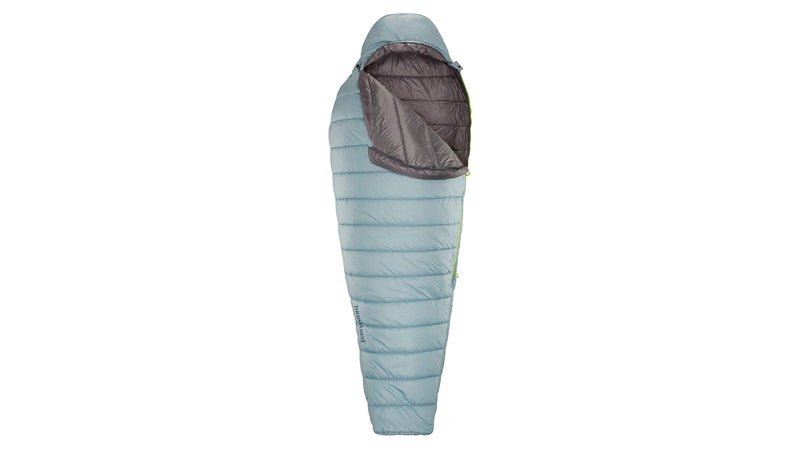
Therm-a-Rest Space Cowboy��($150)
The ��is an ultralight 45-degree summer bag that has become my go-to for tropical traveling, summer nights under the stars, and hut trips. It weighs one pound three ounces and packs to the size of a cantaloupe. That’s slightly bulkier and two ounces heavier than Mountain Hardwear’s $400 Ghost Whisperer, but it’s far smaller than The North Face Lynx, a competing��summer bag that weighs almost two pounds and doesn’t pack down as tightly.
I tested the Space Cowboy on a trip in the Guatemalan highlands, and it was just right for breezy nights. When the wind picked up, I could tuck into its generous hood and zip it snug. Conversely, on a 70-degree summer campout, it was easy to open and use more like a blanket. Some of its versatility, I think, comes partly from the reflective liner at the top of the bag��that helps trap escaping heat��and partly from the purposely uneven distribution of its synthetic insulation. That insulation is concentrated near the torso, where it does the most good. That means the Space Cowboy punches above its weight when snugged tight��but can feel cool when opened up.
One final feature I appreciated: the Space Cowboy has straps that hug a sleeping pad, which kept me centered on my pad no matter how much I rolled around during the night. Like the Ghost Whisperer, it’s a dedicated summer bag, but at $150 it’s much more accessible.
A Comfortable, Albeit Heavy, Backpacking Sleeping Bag
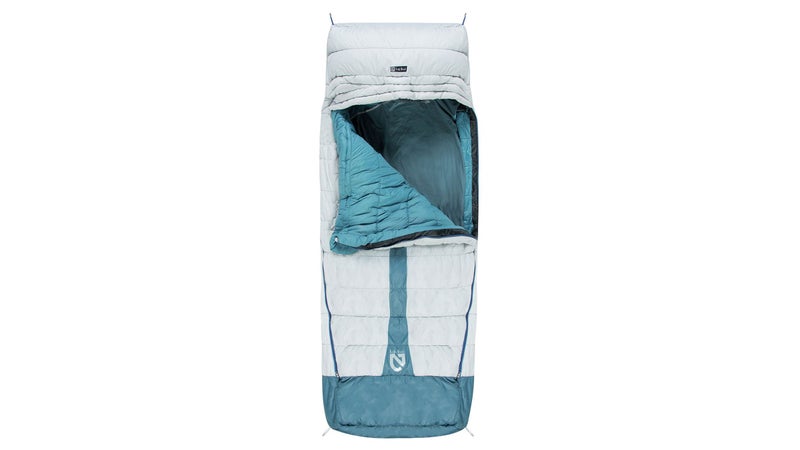
NEMO Jazz��($230)
��is a unique beast. It��mixes high-performance materials in a design focused on bedlike comfort. This is the sleeping bag I brought for my 69-year-old mother when we spent seven days on British Columbia’s Bowron Lake Canoe Circuit, and she loved it.
Rated to 20 Fahrenheit and stuffed with 700-fill water-resistant down, the $230 Jazz has a rectangular shape, a soft-sheet interior, zips down each side, and a sleeve on the bottom that can hold��a plush, four-inch-thick sleeping pad. That adds up to a lot of comfort and a lot of weight. The Jazz weighs five pounds and fills the bottom of a pack, and it’s more than I’d want to take on an extended backpacking trip. But I didn’t notice it on portages, or on leisurely hiking trips with my daughter. Plus, my mom’s already asking where we’re going next summer, and for that, I thank the Jazz.
How We Tested Sleeping Bags
For this test, I recruited ten people to help review bags. The group included sea-kayak guides, dirtbag climbers, ski bums, weekend warriors, families, and even a band of . I aimed to get as many people as possible using the sleeping bags in as many situations as possible. That’s the best way to learn a bag’s strengths and weaknesses, and to learn what kinds of campers will like it. And, for this test, I slept in every sleeping bag I’ve reviewed here.
I’ve been camping for 25 years, including five years as an outdoor guide and ten years as a journalist and gear reviewer. Most years, I spend between four and five weeks sleeping outdoors, and I try to sample bags from all of the major manufacturers.
Bags that caught my interest went��out to my test team, who helped select a group of bags that I singled out for further testing. Which, in this case, meant��more sleeping.
How to Choose a Backpacking Sleeping Bag
Sleeping bags come in a huge range of styles, weights, and warmths. For this review, I focused on sleeping bags that are light and portable enough to carry into the backcountry��and warm enough for sleeping outside on an average summer night. Three pounds and a rating of 45 degrees seemed like appropriate thresholds.
Insulation
It used to be that down and synthetic were the two main insulation types. Down was warmer and more packable for its weight, while synthetic was less expensive, more durable, more insulating��when wet, and hypoallergenic. It’s not so simple anymore.
Hydrophobic treatments now make down more water-resistant, and newer synthetic insulations mimic down in weight and compressibility. And there are creative combinations of both. The upshot is that the insulation landscape has become much more nuanced��and the differences much less pronounced.
Synthetic
I recommend fully synthetic insulation in several situations: if price is a primary concern; if you’re allergic to down; if most of your camping happens in wet environments; and if you’re really hard on your sleeping bags, because synthetic insulation is more durable. The newest synthetic materials, which use clusters of fibers that mimic down, are highly packable and very light, and they almost erase the advantages of feathers. For many recreational users, it’s getting harder to justify paying more for down.
Down
Still, down remains the better choice when weight and packability are most important. But not all down is equal. Fill power, which ranges from a low of around 600 to a high of 900, has an enormous effect��on a bag’s weight and packability.
The other thing to look for is water-resistant down. Most down bags are now stuffed with feathers treated with a hydrophobic coating that resists moisture, which improves performance in wet environments. (DownTek, Allied Down, and Nikwax Hydrophobic Down are some of the brand names to look for.) Some of these treatments are controversial because they contain perfluorocarbons, chemicals that have been linked to cancer and environmental damage. This year, Sierra Designs of its��hydrophobic DriDown treatment to its sleeping-bag line, which includes the Backcountry Quilt��reviewed above. Nikwax’s Hydrophobic Down is also PFC-free.
A second issue is where the down itself comes from. Down is a byproduct of poultry production, and farm conditions and plucking can be inhumane. The North Face, Allied Down, and others have worked to create ethical down standards and ways of tracking the feathers. Look for the Responsible Down Standard and other certifications when shopping.
Hybrids
These are bags containing a mix of down and synthetic insulation, and they come in two forms. The simplest option places down in one part of the bag and synthetic in another. Usually, this means synthetic insulation on the bottom of the bag, because it tends to insulate better when compressed, and down on top. More recently, companies have played around with mixing down and synthetic fibers throughout the bag. Ideally, hybrids offer the durability of synthetic but the feel and compressibility of down.
Temperature rating
Often, a bag’s name will reflect its warmth rating: the REI Co-Op Magma 10, for example, can be used in temperatures as low as 10 degrees, according to REI. Picking the right temperature is the most important decision in the sleeping-bag buying process, and the hardest because temperature is so personal.
Many manufacturers use an independent temperature-testing protocol called EN, or European Norm. Theoretically, the process allows for apples-to-apples comparisons regardless of construction and insulation; two 10 degree��EN-rated bags should feel equally warm. It’s important to note that the EN standard gives two numbers: Lower Limit, which is 10 degrees for the Magma, and Comfort, which is 22 degrees for the Magma. Figuring out how those ratings work for you is really possible only through trial and error. Everything from your sleeping pad to what you ate for dinner, humidity, and wind will all affect how warm you feel. For three-season use and summer in the mountains, I suggest a rating��between 15 and 30 degrees. For summer only, or traveling, bags in the 30-to-45-degree range should work. For shoulder season in the mountains and light winter, 0 to 15 degrees should do the trick. And because women often sleep colder than men, they may want to modify those recommendations by about 10 degrees.
Fit and shape
Sleeping bags come in various shapes: boxy rectangles, tapered mummies, hourglass hybrids, duvet blankets, and a whole spectrum in between. Rectangular bags offer more room for rolling around but tend to be bulkier, heavier, and colder because there’s more space to heat up. More-fitted sleeping bags, usually called mummy bags, are lighter, pack smaller, and feel warmer, but they offer less wiggle room. Various hybrid styles look to find a middle ground between the two.
Weight and packability
A sleeping bag is��one of the bulkiest and heaviest single items you’ll put in your pack, so weight and packability should be considerations, especially if you plan to carry it far. Insulation will play a significant factor in its weight: high-quality down is a lot lighter than low-quality synthetic fibers. But a bag’s zippers, pockets, hood, and fabric can all add significant ounces.
Price
Take two sleeping bags with the same temperature rating, and the less expensive one is almost always going to be bigger and bulkier. But both will still keep you warm at night. For my money, $150 to $400 is a sweet spot for three-season sleeping bags. Within that range, you’ll find high-quality bags, and only someone who is really focused on weight and packability will need to spend more—with one exception: anyone hoping to sleep outside in winter should expect to pay at least $400.
Features
The most obvious sleeping-bag feature is the side zip. Full-length zippers are the standard, while lightweight bags might go with a half zip or even no zip at all. Deluxe bags might add an extra zip across the footbox, which is nice if you get sweaty feet. Whatever you choose, make sure it’s easy to get in and out of the bag. Sticky zippers suck.
If there’s one feature all bags need, it’s a hood. Even in summer, a hood can save you if temps drop. Other features—draft collars along zippers and hoods, pillow pockets, glow-in-the-dark zipper pulls, miscellaneous pockets—can be great, but most add weight. I like sleeves and straps for attaching a sleeping pad, but make sure they play nice with your pad.


